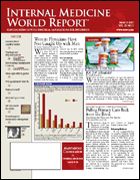Publication
Article
Internal Medicine World Report
HPV Vaccines Closer to Clinical Practice?
HPV Vaccines Closer to Clinical Practice?
By Andrew Bowser
ATLANTA—Competing human papillomavirus (HPV) vaccines are under development in what seems like a race to offer protection against this devastating infection and its deadly cancerous sequelae.
An investigational quadrivalent vaccine against HPV infection currently under development, Gardasil (Merck), has an efficacy of >90% in young women, according to new data presented recently at the Advisory Committee on Immunization Practices (ACIP).
In the first public presentation of data on this new vaccine, Eliav Barr, MD, senior director of biologics and clinical research at Merck, noted that in adolescents of both genders, the vaccine is at least as immunogenic, if not more so, than in older women.
Phase 3 results should be available in the next few months, according to Dr Barr, and it is expected that Merck will submit an application for licensure in the second half of 2005.
GlaxoSmithKline is developing a competing HPV vaccine, called Cervarix,but it appears that Gardasil will reach the market first and be effective against more strains of the virus. New data presented at the ACIP meeting suggests that Cervarix induces high titer antibody responses and “protects against HPV 16/18 associated end points,” said Gary Dubin, MD, vice president of HPV Vaccine Clinical Development Programs for GlaxoSmithKline.
“Our objective is to provide the best possible vaccine for prevention of cervical cancer in women,” said Dr Dubin.
There are significant differences between the composition of these vaccines, as well as the development approach taken by each company.
For example, Cervarix targets HPV types 16 and 18, which together are responsible for about 70% of cervical cancers, according to Dr Dubin. In addition, the vaccine is designed for women only, as reports suggest that male vaccination would provide only “limited” incremental benefit (J Infect Dis. 2005;191:S97-S106) and would be less cost effective (Emerg Infect Dis. 2004;10:1915-1923).
The Gardasil vaccine also targets HPV types 16 and 18, but additionally targets types 6 and 11, which Dr Barr noted are responsible for 90% of genital warts and 25% of cass of mild cervical intraepithelial neoplasia (CIN) in women.
Dr Barr noted that young people are less likely to be concerned about long-term cancer risks than they are about short-term “nuisance” lesions that affect body self-image and immediate health. “Genital warts prevention was the real carrot, as it were, to bring young adults and adolescents into vaccination,” he said.
Gardasil is being evaluated in both genders; specifically, the target populations included in clinical studies have been adolescents (aged 9-<18 years) and sexually active adults (aged 18-45 years).
In a phase 2 study that included 1155 women aged 16 to 23 years, Gardasil showed a 90% efficacy on the combined end point of any HPV infection (types 6, 11, 16, 18), CIN, or genital warts. Efficacy was 100% against both HPV 6- and 11-related infection, and 86% and 89% for HPV 16- and 18-related infection, respectively.
In a separate study, “much higher immune responses” were seen in both male and female adolescents (aged 10-15 years) in comparison with a control group of young women aged 16 to 23 years, Dr Barr reported.
Phase 3 efficacy data in young women (aged 16 to 23) have been submitted to the FDA in a regulatory filing, according to Dr Barr. The clinical studies have enrolled >18,000 patients in 33 countries.
